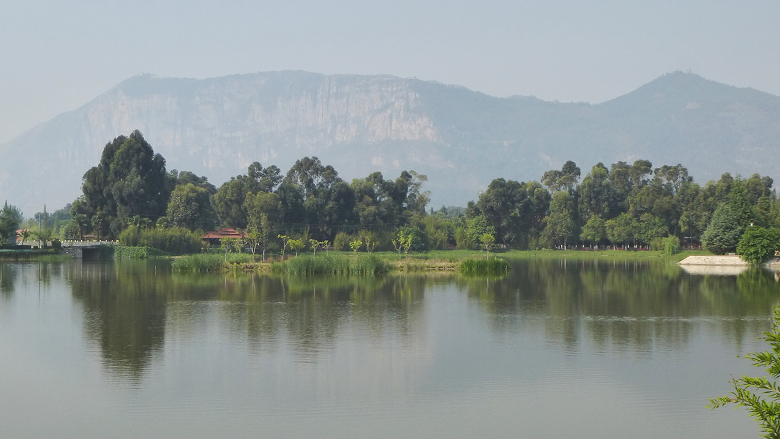Challenge
Located in southwestern China, Yunnan province is one of the country’s most diverse regions, with 30 different ethnic groups representing about 40% of the population. Tourism is a key economic driver in the area, and Yunnan has one of the country’s fastest growing GDPs. Over the past few decades, economic growth ushered in rapid urbanization, which placed a heavy strain on water and sanitation infrastructure. The population surge also resulted in a considerable increase in water pollution.
One of the most visible example of the area’s pollution problem was Dianchi Lake, Yunnan’s largest lake and a primary water source for residents. In the 1980s, Dianchi’s water quality was rated Grade II, according to China’s five-tier water quality assessment system. By the mid-2000s, it had deteriorated to the lowest standard, Grade V (water that is not suitable for human contact or consumption).
Approach
The YUEP built upon the work of similar Bank projects to continue the development of urban and environmental infrastructure services in the Province. YUEP focused on improving the region’s natural resource management and expanding urban water supply, wastewater and solid waste management services.
The project focused on urban environmental infrastructure development and integrated lake basin management. Specifically, YUEP assisted counties in establishing critical urban environment service infrastructure through solid waste management services systems, wastewater and water supply systems, cultural heritage management, river improvement measures, and capacity building for environment monitoring and project management. Besides, the project addressed the management of Dianchi Lake. YUEP assisted the Kunming Municipality in establishing better integrated lake management systems through technical assistance to support policy implementation and the development of monitoring systems. Improved coordination among the agencies responsible for Dianchi Lake was essential. To achieve better sharing of data, the project supported the construction of several water quality monitoring and data management platforms, provided technical assistance to Dianchi Lake management authorities, and developed an Integrated Lake Basin Management Plan.
Results
From 2010 to 2017, the Yunnan Urban Environment Project contributed to the following key results:
- 828,800 urban residents gained access to wastewater treatment services.
- 455,000 urban residents were provided with access to solid waste management services.
- 502,000 urban residents gained access to water supply services.
- There was a total reduction of 3,815 tons per year in Chemical Oxygen Demand pollutants.
- 535 tons per day of municipal solid waste were disposed in sanitary landfills.
- There was a 114 percent average increase in the amount of solid waste disposed to sanitary landfills in tons per day.
- There was an average of 150 percent achievement rate in the population served by wastewater management systems.
- A data-sharing platform was put in place and utilized by agencies/bureaus responsible for Dianchi Lake, resulting in improved management & coordination on lake basin management and generating tens of thousands of water quality monitoring records.
Bank Group Contribution
The World Bank, through two loans from the International Bank for Reconstruction and Development (IBRD), provided financing in the amount of US$130.7 million. In addition, the Bank also brought in global knowledge and technical assistance for policy actions and development of monitoring systems.
Partners
The World Bank coordinated its efforts closely with Yunnan’s Provincial Government, the various municipal, prefectural, and county governments, and local utilities and investment companies. Local Environmental Protection Bureaus assisted in overseeing implementation of the project.
Moving Forward
The project’s support of an Integrated Lake Basin Management plan strengthened the capacity of local authorities to manage and restore Dianchi Lake. A special management agency was established specifically to formulate the plan and bring together several previously disparate and uncoordinated entities.
In the rapidly-growing city of Zhaotong, the project supported the development of the first flood warning and management system (via a smartphone application). The application is being used to provide citizens with warning of flash floods in low-lying municipal areas.
The Project also helped strengthen the capacity of local Project Implementation Units. In Zhaotong, for example, the project implementation unit reported that it had developed and implemented a financial monitoring system for the local government.
Beneficiaries
Urban residents in selected project sites located in Kunming, Lijiang, and Wenshan directly benefited from improved solid waste management, wastewater treatment and access to clean water.
The project’s comprehensive approach to improving urban infrastructure reaped benefits that go beyond the residents living in the project sites. For example, the cultural heritage management subcomponent benefitted both residents at and tourists travelling to the Lion Mountain, while the Integrated Lake Basin Management Plan substantially improved the overall natural environment (and thus recreational and tourism opportunities) in the Kunming area.
